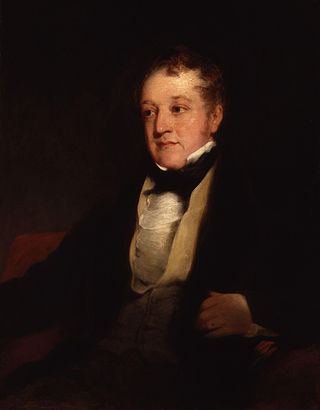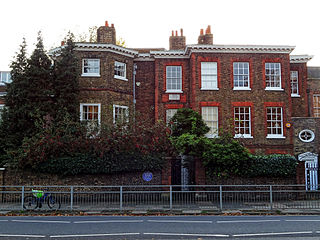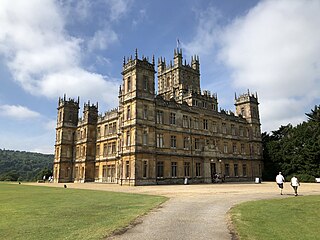
The Commissioners of Woods, Forests and Land Revenues were established in the United Kingdom in 1810 by merging the former offices of Surveyor General of Woods, Forests, Parks, and Chases and Surveyor General of the Land Revenues of the Crown into a three-man commission. The name of the commission was changed in 1832 to the Commissioners of Woods, Forests, Land Revenues, Works and Buildings.
Clergy reserves were tracts of land in Upper Canada and Lower Canada reserved for the support of "Protestant clergy" by the Constitutional Act of 1791. One-seventh of all surveyed Crown lands were set aside, totaling 2,395,687 acres (9,695 km2) and 934,052 acres (3,780 km2) respectively for each Province, and provision was made to dedicate some of those reserved lands as glebe land in support of any parsonage or rectory that may be established by the Church of England. The provincial legislatures could vary or repeal these provisions, but royal assent could not be given before such passed bills having been laid before both houses of the British Parliament for at least thirty days.
The Crown Estate is a collection of lands and holdings in the United Kingdom belonging to the British monarch as a corporation sole, making it "the sovereign's public estate", which is neither government property nor part of the monarch's private estate.

A royal forest, occasionally known as a kingswood, is an area of land with different definitions in England, Wales, Scotland and Ireland. The term forest in the ordinary modern understanding refers to an area of wooded land; however, the original medieval sense was closer to the modern idea of a "preserve" – i.e. land legally set aside for specific purposes such as royal hunting – with less emphasis on its composition. There are also differing and contextual interpretations in Continental Europe derived from the Carolingian and Merovingian legal systems.

The Northern Development, Mines, Natural Resources and Forestry is a government ministry of the Canadian province of Ontario that is responsible for Ontario's provincial parks, forests, fisheries, wildlife, mineral aggregates and the Crown lands and waters that make up 87 per cent of the province. Its offices are divided into Northwestern, Northeastern and Southern Ontario regions with the main headquarters in Peterborough, Ontario. The current minister is Greg Rickford.

The South Australia Act 1834, or Foundation Act 1834 and also known as the South Australian Colonization Act, was an Act of the Parliament of the United Kingdom which provided for the settlement of a province or multiple provinces on the lands between 132 degrees east and 141 degrees of east longitude, and between the Southern Ocean, and 26 degrees south latitude, including the islands adjacent to the coastline.

The Court of Wards and Liveries was a court established during the reign of Henry VIII in England. Its purpose was to administer a system of feudal dues; but as well as the revenue collection, the court was also responsible for wardship and livery issues.

The post of Surveyor General of Woods, Forests, Parks and Chases was an office under the English Crown, charged with the management of Crown lands. The office was at one time divided between surveyors south and north of the River Trent, but in the 18th century, the two posts were combined. In 1810, by the Crown Lands Act 1810, later amended by the Crown Lands Act 1829, the functions of the post were merged with those of the Surveyor General of the Land Revenues of the Crown and became the responsibility of a new body, the Commissioners of Woods, Forests and Land Revenues.
The Commissioners of Woods, Forests and Land Revenues were officials under the United Kingdom Crown, charged with the management of Crown lands. Their office were customarily known as the Office of Woods.
The Commissioners of Crown Lands were charged with the management of United Kingdom Crown lands. From 1924 to 1954, they discharged the functions previously carried out by the Commissioners of Woods, Forests and Land Revenues. There were three commissioners at any one time: the Minister of Agriculture, the Secretary of State for Scotland and one permanent commissioner.

The Hon. George Villiers was a British courtier and politician from the Villiers family. The youngest son of the diplomat Lord Hyde, he was an intimate of Princess Amelia and personal supporter of her father, George III. His favour within the Royal Family and his father's influence brought him a number of sinecures to support him. However, Villiers was more interested in the operation of the royal farms at Windsor Castle than in politics or the duties of his offices. When his bookkeeping as Paymaster of the Marines was carefully examined in 1810, Villiers' carelessness and the speculation of his clerk had left him in debt to the Crown by more than £250,000. This exposure touched off a public scandal; Villiers promptly surrendered all his property to the Crown and threw himself on the king's mercy. The misconduct of Joseph Hunt as Treasurer of the Ordnance to some extent obscured Villiers' own misconduct, and he was able to retain other sinecures and a stable, if reduced, income from them until his death in 1827.
Thomas Cromwell established the Court of Augmentations, also called Augmentation Court or simply The Augmentation in 1536, during the reign of King Henry VIII of England. It operated alongside three lesser courts following the dissolution of the monasteries. The Court's primary function was to gain better control over the land and finances formerly held by the Roman Catholic Church in the Kingdom of England. The Court of Augmentations was incorporated into the Exchequer in 1554 as the Augmentation Office.

Sylvester Douglas, 1st Baron Glenbervie, PC, KC, FRS, FRSE, FSA was a British lawyer, politician and diarist. He was Chief Secretary for Ireland between 1793 and 1794.
John Monckton of Serlby, Nottinghamshire, was a British landowner and Whig politician who sat in the House of Commons between 1727 and 1751. He was elevated to the Irish peerage as the first Viscount Galway in 1727.
The Honorable John St John (c.1746–1793) was an English MP and surveyor general of Crown lands.

The Old Court House is a Grade II* listed house located off Hampton Court Green in the London Borough of Richmond upon Thames; its origins date back to 1536. The architect Sir Christopher Wren, who lived there from 1708 to 1723, was given a 50-year lease on the property by Queen Anne in lieu of overdue payments for his work on St Paul's Cathedral. The lease passed from Wren's son to his grandson. It was purchased from the Crown Estate in 1984.
Arthur Cates was an English architect.

Robert Sawyer Herbert of Highclere Castle, Hampshire, was a British politician who sat in the House of Commons for 46 years from 1722 to 1768.









